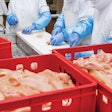Sanderson Farms, Inc. on February 21 reported to shareholders a net loss of $6.9 million for the first fiscal quarter ended January 31.
That loss equates to a decline of 31 cents per share over the past quarter, compared with a net loss of $8 million, or 36 cents per share for the first quarter of 2012.
Net sales for the first quarter of fiscal 2013 were $595.8 million compared with $517.8 million for the same period a year ago.
"Our results for the first quarter of fiscal 2013 reflect improving, but still challenging, conditions for our industry," said Joe F. Sanderson, Jr., chairman and chief executive officer of Sanderson Farms, Inc. "While we experienced higher poultry market prices than the same period a year ago, our grain costs were also higher. Retail demand for chicken has remained steady, but we continue to see weak food service demand. We believe food service demand will remain under pressure until the national employment environment improves. While grain prices have retreated from the highs they set last August, we experienced higher feed costs during the first quarter, and these higher costs continue to affect our profitability."
According to Sanderson, market prices for poultry products were higher during the first quarter of fiscal 2013 compared with the same period of fiscal 2012. A simple average of the Georgia dock price for whole chickens was approximately 9.1 percent higher in the Company's first fiscal quarter compared with the same period in 2012, and currently stands at a record $1.0050 per pound.
Boneless breast meat prices during the quarter were approximately 5.1 percent higher than the prior-year period. The average market price for bulk leg quarters decreased approximately 2.0 percent for the quarter compared with the same period last year. Jumbo wing prices were higher by 24.6 percent compared with last year's first fiscal quarter, and hit a record high of $1.92 per pound the week before the Super Bowl. The Company's average feed cost per pound of poultry products processed increased 12.1 percent compared with the first quarter of fiscal 2012, and prices paid for corn and soybean meal, the Company's primary feed ingredients, increased 16.2 percent and 46.1 percent, respectively, compared with the first quarter of fiscal 2012.
"Market conditions steadily improved during our first fiscal quarter as our grain costs peaked in November," Sanderson added. "Market prices and sales strengthened in January and, as a result, the Company was profitable for the last month of the quarter." However, we continue to experience high grain prices, and expect a challenging cost environment throughout the fiscal year. Corn supplies are at their tightest level in 15 years, which will likely keep upward pressure on grain costs at least until the market gets some visibility into the quantity and quality of the 2013 crops.
"Throughout most all of calendar 2012, egg sets and pullet placements remained below previous year levels, but have trended higher over the past few weeks. Despite slightly higher chicken production, market prices have remained the same or moved higher, indicating at least some improvement in demand. We are cautiously optimistic regarding macroeconomic conditions, and believe any further strengthening of the United States economy, coupled with normal seasonal demand improvement this spring and summer, could support higher market prices for our poultry products.
"We have been running our plants at approximately 94 percent capacity since October, which has adversely affected our costs. In order to meet our customers' demands and improve our cost structure, we will move our plants to full production in June. While grain costs remain relatively high, this move is supported by demand from our customers and our desire to keep our costs competitive," concluded Sanderson.















